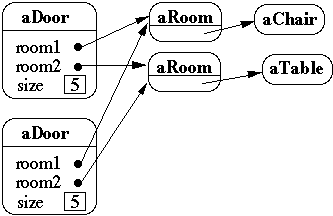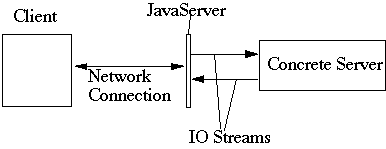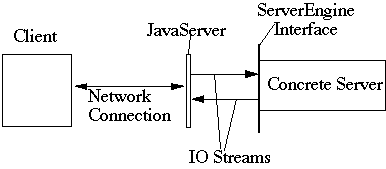 CS 596: Client-Server Programming
CS 596: Client-Server ProgrammingDoc 10, Prototype
 CS 596: Client-Server Programming
CS 596: Client-Server Programming
| Prototype | slide # 2 |
| ...Intent | slide # 2 |
| ...Applicability | slide # 2 |
| ...Implementation/Sample Code | slide # 3 |
| ...Cloning Issues | slide # 4 |
| ......How to in C++ - Copy Constructors | slide # 4 |
| ......How to in Java - Object clone() | slide # 5 |
| ......Shallow Copy Verse Deep Copy | slide # 6 |
| ...Example of Prototype | slide # 8 |
| ...Consequences | slide # 15 |
| ...Implementation Issues | slide # 15 |
class Prototype
{
public Prototype clone()
{
code to make a copy of current Prototype object
return clone;
}
// add what ever else you want the class to do
}
class Protoplasm extends Prototype
{
public Prototype clone()
{
code to make a copy of current Protoplasm object
return clone;
}
// add more other stuff
}
ClientCodeMethod( Prototype example )
{
Prototype myCopy = example.clone();
// do some work using myCopy
}class Door
{
public:
Door();
Door( const Door&);
virtual Door* clone() const;
virtual void Initialize( Room*, Room* );
// stuff not shown
private:
Room* room1;
Room* room2;
}
Door::Door ( const Door& other ) //Copy constructor
{
room1 = other.room1;
room2 = other.room2;
}
Door* Door::clone() const
{
return new Door( *this );
}
Creates a clone of the object. A new instance is allocated and a bitwise clone of the current object is place in the new object.
Returns:
class Door implements Cloneable
{
public void Initialize( Room a, Room b)
{ room1 = a; room2 = b; }
public Object clone() throws
CloneNotSupportedException
{
return super.clone();
}
Room room1;
Room room2;
}




JavaServer handles the network connection.
Algorithm:
class JavaServer
{
ServerSocket acceptor;
public JavaServer( int portNumber )
{
acceptor = new ServerSocket( portNumber );
}
public void run()
{
while (true)
{
Socket client = acceptor.accept();
InputStream cin = client.getInputStream();
OutputStream cout = client.getOutputStream();
processClientRequest( cin, cout );
}
}
private void processClientRequest( InputStream cin,
OutputStream cout )
{
DateServer handler = new DateServer( cin, cout);
handler.processClientRequest();
}
}
class AirlineReservationJavaServer extends JavaServer
{
ServerSocket acceptor;
public AirlineReservationServer( int portNumber )
{
super( portNumber );
}
private void processClientRequest( InputStream cin,
OutputStream cout )
AirlineReservation handler;
handler = new AirlineReservation( cin, cout );
handler.processClientRequest();
}
}
Declare variables to be instances of the abstract class not instances of particular classes
interface ServerEngine
{
public ServerEngine clone( InputStream in,
OutputStream out );
public void processClientRequest();
}

class JavaServer
{
ServerSocket acceptor;
ServerEngine serverPrototype;
public JavaServer( int portNumber, ServerEngine aCopy)
{
acceptor = new ServerSocket( portNumber );
serverPrototype = aCopy;
}
public void run() {
while (true)
{
Socket client = acceptor.accept();
InputStream cin = client.getInputStream();
OutputStream cout = client.getOutputStream();
processClientRequest( cin, cout );
}
}
private void processClientRequest( InputStream cin,
OutputStream cout )
{
ServerEngine handler;
handler = serverPrototype.clone( cin, cout);
handler.processClientRequest();
}
}
Driver Programclass DriverProgram
{
public static void main( String args[] )
{
ServerEngine aFactory = new DateServer();
JavaServer networkListener;
networkListener = new JavaServer( 6666, aFactory );
networkListener.run();
}
}